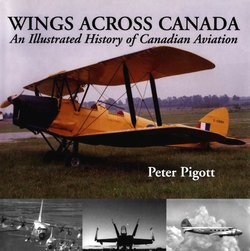Читать книгу Wings Across Canada - Peter Pigott - Страница 10
На сайте Литреса книга снята с продажи.
ОглавлениеCourtesy of De Havilland Canada
Tiger Moth.
THE TIGER MOTH
Given birth by the Golden Age of flying in the 1920s, the De Havilland Tiger Moth became the basic pilot trainer for Commonwealth air forces during the Second World War, serving with the Royal Air Force until 1953. When, between the world wars, flying developed into a fad for youthful aviation enthusiasts (both male and female) the director of British Civil Aviation, Sir Sefton Branckner, looked for a cheap, uncomplicated airplane with which to launch a national flying club scheme. And so was born one of the most beloved biplanes in aviation history: the De Havilland Tiger Moth.
Geoffrey de Havilland said that he built the two-seat biplane for his own use and, as a natural history hobbyist, thought the name “Moth” perfect, keeping to that family of insects to name the whole series of light aircraft. On February 22, 1925, he test flew the first Moth, the DH 60 Cirrus, himself. It wasn’t only the aircraft’s robust simplicity that attracted the public, but the fact that it was an affordable £885, the price of a car — and indeed, with the wings folded, it could be towed by the family car. It was the first “people’s plane,” and it was said anyone could learn to fly or service a Moth, so uncomplicated were its controls and engine. Branckner agreed and ordered ninety, putting De Havilland into the main ranks of British aircraft builders. The Royal Air Force had misgivings about its lack of forward visibility and the maze of struts that hampered access to the front (or student’s) cockpit. To overcome both these defects, the DH 60 evolved into the DH 82 Tiger Moth, which would fly on October 26, 1931. Distinguished by its swept-back wings for improved cockpit access and powered by a 120 hp inline Gipsy four-cylinder engine (which by 1937 had been upgraded to a 130 hp engine), it cruised comfortably at 100 miles per hour, had a ceiling of 13,600 feet, and had a range of 285 miles. In fine weather, the Tiger Moth was a delight to fly. By the time the war began, 1,153 Tiger Moths had been built, and it was the Royal Air Force’s basic trainer.
Geoffrey de Havilland would never have guessed how many millions of pilots worldwide would learn to fly on his aircraft before moving on to Harvards and Ansons, and ultimately Spitfires, Lancasters, and commercial airliners. Simple enough to be built by even the most basic aircraft industry, Tiger Moths were made in four dominions (with a few variations), as part of the British Commonwealth Air Training Plan. De Havilland Canada turned out 1,747 Tiger Moths as the DH 82C, distinguished by their enclosed canopies; some had 160 hp Pirate D.4 engines. There were 345 manufactured in New Zealand, and in Australia, the 1,085 Tiger Moths built locally were known as Jackaroos. Of the many historic flights that Tiger Moths made in Canada, one of the most colourful took place on June 24, 1968. To commemorate the fiftieth anniversary of Canada’s first airmail flight, Trans Canada Airlines captain Donald Chamberlin and ex-RCAF pilot Thomas Lee re-enacted the famous flight with a Tiger Moth. The original pilot, Captain Brian Peck of the RAF, had used a Curtiss Jenny to fly 120 letters in a mail sack from Montreal’s Cartierville Airport (then Bois Franc polo grounds) to Toronto’s Leaside airfield, completing the trip in seven hours. A co-owner of the Tiger Moth, Chamberlin took same number of letters in the original mailbag from thirteen-year-old Brian Peck, Captain Peck’s grandson. The Tiger Moth made the flight in five hours, with the same stops at Kingston and Desoronto, and landed at Malton Airport, as Leaside had become a suburb of Toronto.
